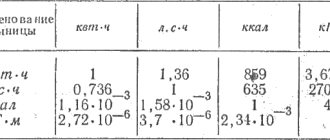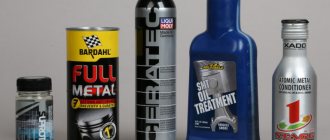Today on sale you can find various additives for engine restoration, solutions for cleaning the fuel system and improving fuel quality, compositions for protecting internal combustion engine and gearbox parts from wear, etc.
As for the engine, manufacturers of such compounds promise motorists the restoration of worn-out components, improved performance of the power unit, increased service life and stability of the engine oil (thickener additives), engine cleaning, creation of a protective layer on rubbing surfaces (for example, molybdenum additive), etc. .
As a result, you can count on increased power, stable engine operation with a minimum of noise and vibration, improved efficiency, reduced oil and fuel consumption, as well as a longer service life of the power unit. Let us note right away that although advertising promises look tempting, in practice many owners often did not notice any real benefits after using such additives.
According to manufacturers, this situation should be changed after entering the market by Suprotek products, which, according to the developers, actually work. Let's look at whether this is actually true, as well as what features and nuances need to be taken into account if you plan to use Suprotec in an engine or other units.
Description, composition and properties of the product
Suprotec Active Plus is a special additive for gasoline engines with a mileage of more than 50 thousand km.
The composition does not change the properties of motor oil and is not an additive (although, out of habit, some motorists classify it specifically in this category of auto chemicals). According to the manufacturer’s recommendation, the composition can also be used in vehicles that use gas as fuel.
The drug contains metal-ceramic particles that create a new layer on the surfaces of engine parts, which partially restores the factory dimensions and geometry of worn parts. The consequence of using Suprotek Active Plus gasoline is an increase in compression, the disappearance of extraneous sounds in the engine compartment, easier cold starts, a reduction in exhaust smoke, oil and fuel consumption.
What manufacturers say
Suprotec additives (ACTIVE, ACTIVE PLUS, ACTIVE REGULAR, OFF-ROAD 4X4 internal combustion engines , which are used for both gasoline and diesel engines) create a special layer that facilitates sliding, eliminating runouts and excessively large gaps. That is, the coating is formed on the inner surface of the cylinders, the outer surface of the rings, seats and journals of the camshafts and crankshafts. This process occurs very slowly, over 5–10 thousand kilometers, and its effect lasts for many years. In addition, the Suprotek company produces flushes that clean the engine of oily deposits and dirt, thereby improving the supply of oil to parts, which means extending their service life. Flushing Suprotec Motor Flush not only cleans the oil system, but also prepares the rubbing surfaces for the formation of a protective film.
Application
Suprotek additive for gasoline engines is recommended for use in the following cases:
- increased engine oil consumption;
- reduction of compression;
- drop in engine oil pressure;
- knocking of hydraulic compensators;
- problems with cold engine starting;
- ICE triples;
- knocking and other extraneous sounds are heard from the engine compartment;
- reduction in engine power;
- increased gasoline consumption;
- smoke in the exhaust.
Also, the Suprotek engine oil additive can be used to prevent the occurrence of the above-described and other power unit problems in domestic and imported cars with high mileage (over 50 thousand km).
Important! The use of the composition is not recommended for mechanical damage to engine parts.
Instructions for use
Engine processing takes place in three stages.
Stage 1. Pour the product into the oil with mileage 1 thousand km before the regular replacement. Drive to the lubricant change as usual, fill in new engine oil and change the oil filter.
Stage 2. Pour the drug into new engine oil, drive to the regular oil change, replace the lubricant and oil filter.
Stage 3 is similar to the second.
Important! If necessary, when changing car oil, you should change not only the oil filter, but also the air and fuel filters.
In the case when the car’s mileage is more than 80 thousand km, and the engine is being treated for the first time, at the 1st stage, 200 km before changing the engine oil, the manufacturer recommends additionally using “Long-term flushing for the Suprotek engine”.
Having studied how to use the Suprotek additive for a gasoline engine, it is necessary not only to accurately follow all stages, but also the dosage of the drug. With an oil system volume of up to 5 liters per treatment, one bottle of the product is sufficient. If the volume of the lubrication system is more than 5 liters, then two bottles should be filled at a time.
Important! If at the first stage you fill the mixture earlier than 1 thousand km before changing the engine oil, you need to periodically take a drop sample of the technical fluid. If the lubricant becomes too dark and/or dense, it must be urgently replaced along with the oil filter.
How to use this additive
First of all, read the instructions for use. Each manufacturer may have its own sequence of use.
General recommendations include:
And so you should complete the required number of steps, depending on the mileage.
The dosage of the additive should always be observed. You shouldn't add just any amount. Many people mistakenly think that the more you pour, the better. This can only ruin everything.
What happens if you add more additive than normal?
Advantages and disadvantages
The only drawback of Suprotec for a gasoline engine is its price. However, if you evaluate the positive effect of the drug on the power unit, it becomes clear why the motorist pays that kind of money.
The advantages of the product include:
- reduction of oil and fuel consumption;
- elimination of exhaust smoke;
- cold start relief;
- increasing engine power;
- reduction of vibration and noise in the engine;
- improving the environmental friendliness of exhaust;
- eliminating the knocking of hydraulic compensators;
- reliable engine protection and increase in its service life.
Additives and additives "SUPROTEC": features and principle of operation
Let's start with the fact that thanks to an active advertising campaign, Suprotek products are well known among car enthusiasts. The manufacturer claims that the additives are manufactured using unique modern technology. Such solutions are based on in-depth scientific research regarding the interaction of metal surfaces and parts of the power unit, gearbox and other components with structured ultrafine powder compositions.
Simply put, after the Suprotek additive, which contains mineral powder, gets into, for example, a car engine, this powder settles on the parts. The result is a protective layer that also promotes improved lubrication and minimizes friction. This means that the service life of the parts will also be increased.
In any case, depending on the purpose, each group has a special lubricant composition, which begins to work step by step in components and assemblies. These steps are as follows:
- filling the composition and cleaning;
- surface distribution;
- formation of a protective layer;
After the composition enters the unit, the process of cleaning the internal surfaces begins due to the “abrasive” structure of the mineral powder. In the case of an engine, the powder is in the oil. This means that you should not expect quick results as the cleansing definitely takes time.
Further, during the operation of the internal combustion engine, the main component of the additive is distributed over the surfaces, filling small scratches, cracks, burrs and other defects on metal parts. A so-called tribostructure is formed.
Then the additive begins to perform its protective functions, strengthening the surfaces and reducing the coefficient of friction. It should also be emphasized that the formed layer is not only resistant to mechanical stress, but is also better able to retain lubricant. The result is improved lubrication of the part with engine oil.
Let us add that the components interact exclusively with metals, which makes it possible to make the additive completely neutral to other rubber elements (gaskets, oil seals, seals, fuel lines, etc.). In addition to protection, this layer has the properties of “retaining” engine oil. As a result, the base lubricant becomes more effective. As you can see, the additive allows you to partially increase the gaps, as well as improve the performance of components and mechanisms without disassembling and repairing them.
Useful properties of Suprotek
Before adding the Suprotec additive to the power unit, you need to understand what beneficial functions it has on it.
They are as follows:
- cold engine starts are made easier, that is, the engine starts better at any time of the year;
- reduction in fuel consumption, in fact, after adding this additive, the engine consumes less fuel;
- power increases, as the engine mechanisms begin to spend less energy on overcoming friction between themselves;
- stabilization of compression, this is caused by the fact that all cracks and scratches are repaired on individual damaged parts and components, which automatically leads to an increase in compression and also helps to reduce engine oil consumption.
This effect on the heart of the machine is taken not only from the tests carried out, the technical characteristics of the supratek, as well as documentation. The main thing is that this is evidenced by the reviews of drivers who decided to use this additive in their cars.
Car enthusiasts will also be interested in the information that some other materials for use in cars are produced under the Suprotec brand, namely:
- compositions for adding to automatic and manual transmissions, which also clean parts and mechanisms of any type of transmission;
- Injection pump for diesel engines, in this case Suprotec cleans and protects diesel fuel systems well;
- lubricants that are used for bearings and CV joints;
- power steering mechanisms, the Suprotec additive used for this purpose, help clean all the parts and mechanisms of these automobile units, and also improve the sensitivity of the steering in general;
- gearboxes and axles, special fluids created for use in these automotive components, also have a cleaning and protective function.
As you can see, the types of Suprotec additives are extensive, and are created for those components and assemblies that are subject to the greatest wear.
Among all the additives used in motor oils, the Suprotec brand occupies a special place. Its products (additives) are characterized by the fact that they do not dissolve in oil, but, thanks to their molecular structure, clean the surfaces of engine parts from rust, oxidation and carbon deposits, and then envelop them in a thin, durable film. In addition, Suprotek penetrates into small cracks and scratches in the metal, and, filling them, restores the integral structure of the surface.
Using Suprotec in an engine: what results should you expect?
So, if we talk about the effectiveness of Suprotek in engines, a number of features should be taken into account. First of all, if the engine is new or has virtually no wear, you should not expect a quick effect. In simple words, the owner will experience virtually no changes.
In this case, the composition will still work, reducing friction and protecting parts. In some cases, there is even a slight decrease in oil consumption due to waste and a reduction in fuel consumption. The main advantage is that in the future the service life of such an engine increases, as the mechanical wear of rubbing surfaces decreases.
As a result, the engine starts easier, surface lubrication improves, fuel burns better in the cylinders, gas breakthrough into the crankcase is reduced, engine oil ages more slowly, etc. In simple words, the engine runs less noisily, spins up easier, wears out less, burns fuel efficiently, exhaust becomes less toxic, etc. The driver can also note that oil consumption is reduced, fuel savings are achieved, and the effect of oiling the spark plugs disappears.
If we talk about heavily worn engines that have significantly lost power, consume a lot of oil, have low cylinder compression, smoky exhaust, noticeable knocking noises are heard during operation, etc., in this case, the use of Suprotek or any other compounds will be ineffective .
"Suprotek" for gasoline and diesel engines
The product line of this manufacturer should include formulations for both gasoline and diesel internal combustion engines. If in the case of an engine additive (introduced into engine oil) everything is more or less clear, the division itself into gasoline and diesel is more about protecting and improving the operation of power systems (fuel additives).
As you know, the injection systems of gasoline and diesel units are very different. If in gasoline engines it is often necessary to pay special attention to injection nozzles, in a diesel engine, in addition to injectors, there is also a fuel injection pump.
How to use Suprotec: subtleties and nuances
First of all, before using Suprotec, you must separately study the instructions regarding the use of this drug. As for general recommendations, the following are highlighted:
- Before use, you need to shake the bottle to mix the base liquid and fine mineral powder, which precipitates. Adding an additive involves pouring it into engine oil or fuel.
- For new engines and engines with mileage up to 50 thousand km. processing is carried out in 2 stages. For internal combustion engines with a mileage of 80 thousand km. and up to 200 thousand km. processing involves 3 stages. Motors with mileage of more than 200 thousand km. processed in 4 stages.
So, the initial stage in relation to additives into the engine involves introducing the additive within 1-1.5 thousand km. before the expected oil change. After the specified number of kilometers, the waste is drained from the engine, fresh oil is poured in, and the protective composition is added again.
It should also be noted that if the drain was dirty when drained, it is also recommended to flush the engine before changing the oil. The remaining stages are similar to the second, that is, at the next oil change, the composition is refilled, and the number of repetitions of its use depends on the mileage mentioned above.
To put it simply, some drivers believe that the more additive you add and the more often you use it, the better the effect you can achieve. In fact, this is strictly prohibited!
In the case when an oil additive is used, then the loads on the parts in this case can increase significantly, since the thickness of the formed protective layer will be too large, the composition will begin to work as a strong abrasive, thereby wearing out friction pairs and loaded surfaces. If we are talking about fuel additives, an excess of the composition can clog the injectors, damage the injection pump, etc.
It is important to understand that the tribological composition, which was already mentioned above, is not immediately washed off and is erased during further use. In other words, the effect is prolonged. This means that even if Suprotek was previously used, and then fresh oil without an additive was added, the protective layer on the parts is preserved. For this reason, the unregulated use of a large number of such compounds can only harm the power unit and other components.
Types of Suprotek additives
Additives for restoring the Suprotek engine are presented in the retail chain in a large assortment, which can be quite difficult for an inexperienced motorist to understand. This variety is necessary, because there are a huge number of different engine models. Also, cars can differ significantly in the power of the power unit, as well as in the intensity of use of the car.
The most popular types of these products are:
1. “Active plus gasoline” - the use of this composition is recommended only in gasoline engines and in units running on natural gas.
The maximum efficiency of using this additive can be achieved on cars with a mileage of 50,000 km and above. Can be purchased for 1300-1500 rubles.
It is also important to correctly pour Active Gasoline into the oil. The substance is added in 2 doses
The first time the geomodifier is added to the oil on which the car engine has traveled at least 1000 km, and the second time when replacing the lubricant.
Video:
2. “Active Plus Diesel” - the additive is used exclusively to restore and prevent wear of diesel engines.
“Active Diesel” can be used both on passenger cars running on diesel fuel and on light and medium-duty trucks. The method of adding a geomodifying composition to oil is absolutely identical to adding an additive to gasoline engines. The average price of a product is 1,500 rubles.
3. “Universal 100” - additives are used only for the restoration of worn-out passenger car engines with a mileage of at least 200,000 km.
To obtain stable results, the addition of the composition must be done in 4 stages. The price of the additive “Universal 100” is on average 1150 rubles.
4. “Max-200 Sporttek” - this additive is the most expensive (4,500 rubles), but when operating a sports car, only this type of geomodifying additive is allowed to be added to the oil.
It is recommended to use the Max-200 Sporttek in 2 stages. The first time the additive is poured during test runs before the start of the races. Then, after changing the oil and filter, the additive is added again in a proportion of 10 ml per 1 liter of oil.
5. “Engine flush” is an oil additive designed primarily to remove various deposits formed during engine operation.
There is a need to use this additive when using low-quality fuels and lubricants, as well as when changing engine oil untimely. “Engine Flushing” is added to the old oil immediately before the procedure for replacing it. The cost of washing is around 400 rubles.
Video:
Let's sum it up
As you can see, the use of Suprotek additives or similar original formulations from other well-known manufacturers in some cases has a positive effect. However, many car enthusiasts, especially given the lack of awareness, mistakenly regard the additive as an alternative to engine repair.
Finally, we note that the overall efficiency and effectiveness of the additive directly depends on the condition of the engine or any other component, as well as the correct use. The additive must be used according to the manufacturer's recommendations, which are specified in the instructions.
Using engine additives: deception, benefit or harm. Practical operation of motors after using the additive, results. Recommendations.
Use of anti-wear, anti-smoke and other additives to reduce oil consumption. Pros and cons after applying the additive to the engine.
How do additives with molybdenum work? Is it worth using motor oil with this additive in the engine? Practical application of molybdenum and results.
Protective and restorative additives for engines: operating principle. In what cases are oil additives used, what to expect after use.
Low compression in engine cylinders: the main reasons. How to increase engine compression without engine repair, available methods. Tips and tricks.
What is a thickener additive, a motor oil stabilizer as a separate solution or as part of a complex product. Is it worth using in internal combustion engines?
I drove as much as 15,000 on my oil, got tired and almost forgot to change it. I decided to fill in the same oil as before - Castrol EDGE FST 5W-30. But then the “Main Road” caught my eye with an advertisement for Suprotek and I decided to try it, especially since some people criticize the same additives, while others, on the contrary, praise them, and for Suprotek, even if 99% of the reviews were paid, there were some negative reviews I didn’t find it at all from those who actually tried it. Maybe I was looking wrong? In general, I decided to try it myself while my finances allow it, maybe my gasoline consumption will decrease, otherwise I’m already tired of burning 13 liters per 100 km.










